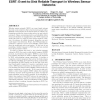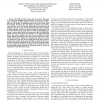279 search results - page 48 / 56 » Randomized k-Coverage Algorithms For Dense Sensor Networks |
INFOCOM
2009
IEEE
14 years 2 months ago
2009
IEEE
—Tracking of movements such as that of people, animals, vehicles, or of phenomena such as fire, can be achieved by deploying a wireless sensor network. So far only prototype sys...
MOBIHOC
2003
ACM
14 years 7 months ago
2003
ACM
Wireless sensor networks (WSN) are event based systems that rely on the collective effort of several microsensor nodes. Reliable event detection at the sink is based on collective...
MOBISYS
2004
ACM
14 years 7 months ago
2004
ACM
In this paper, we investigate the impact of radio irregularity on the communication performance in wireless sensor networks. Radio irregularity is a common phenomenon which arises...
ICC
2007
IEEE
14 years 1 months ago
2007
IEEE
— We address a lifetime maximization problem for a single-hop wireless sensor network where multiple sensors encode and communicate their measurements of a Gaussian random source...
IJDSN
2006
13 years 7 months ago
2006
The ability of sensor nodes to enter a low power sleep mode is very useful for extending network longevity. We show how adversary nodes can exploit clustering algorithms to ensure ...


